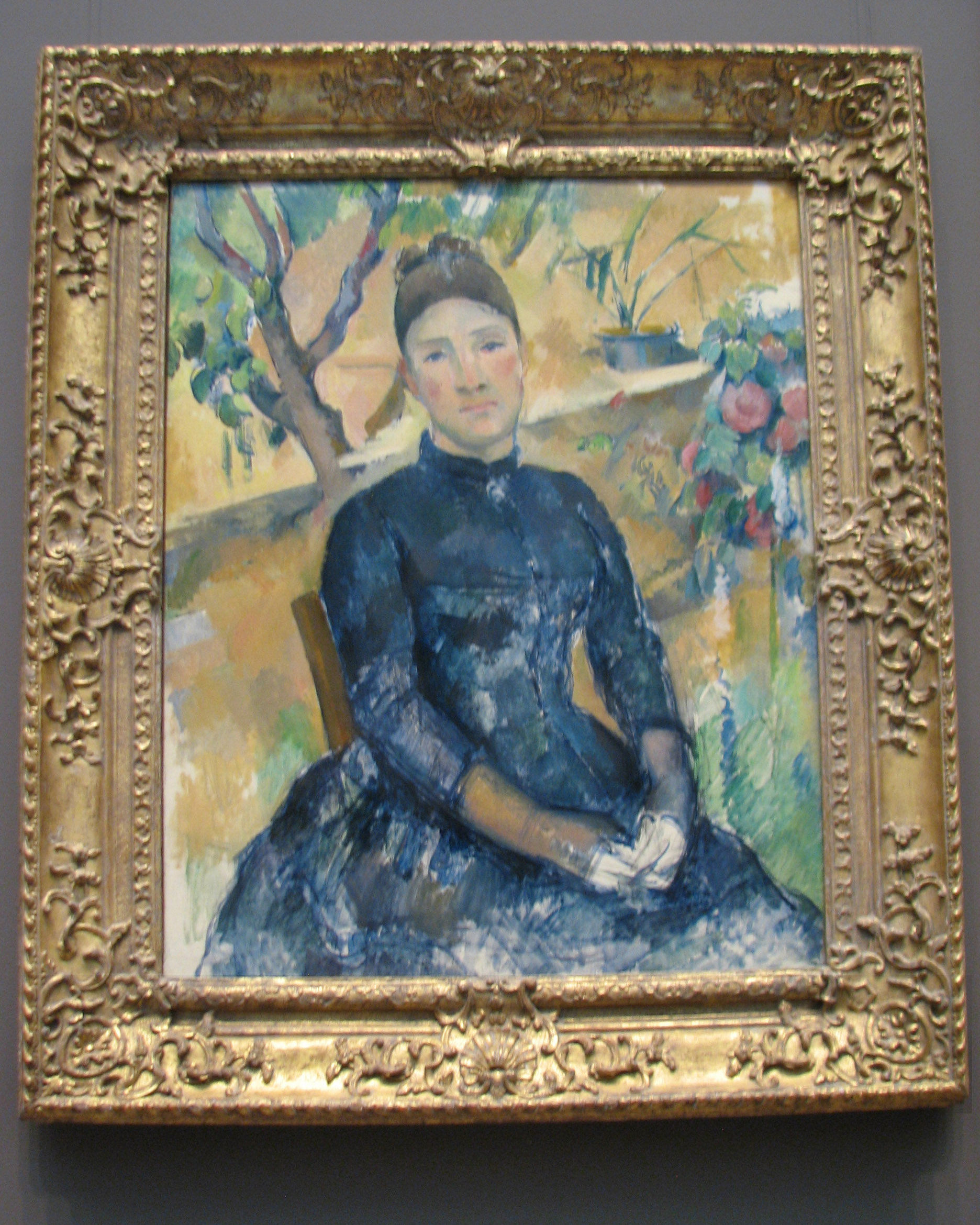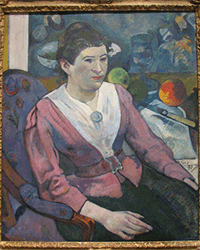
Madame Cézanne (Hortense Fiquet, 1850–1922) in the Conservatory, 1891
Paul Cézanne (French, Aix-en-Provence 1839–1906 Aix-en-Provence)
Oil on canvas, 36 1/4 x 28 3/4 in. (92.1 x 73 cm)
Bequest of Stephen C. Clark, 1960, MMA 61.101.2
|
"Cézanne met Hortense Fiquet, a former artist's model, about 1869, but they did not marry until 1886. By that date, their son, Paul, was fourteen. According to him, this portrait was painted in 1891 in the conservatory of Jas de Bouffan, the Cézanne family estate, near Aix-en-Provence. Of the more than two dozen paintings for which Hortense posed, this unfinished canvas offers compelling insight into Cezanne's working method."(From the info card): In the 1870s, Cézanne's paintings are Impressionist, having learned much from his colleague Pissarro, who encouraged him to paint more from observation than imagination. But then Cézanne's art evolved into something quite different. Émile Henri Bernard, a Post-Impressionist painter, who was a friend of Cézanne, made the "assertion [...] that the artist transcends impressionism and, 'far from being spontaneous, [is indeed] reflective.'" (Cézanne and the End of Impressionism, by Richard Shiff, page 127) Even though Cézanne's painting above has large patches of color and even spots where the canvas is bare, one senses an analytical process underlying the results. Maurice Merleau-Ponty, a French phenomenological philosopher, explains, "If the painter is to express the world, the arrangement of his colors must bear within this indivisible whole, or else his painting will only hint at things and will not give them in the imperious unity, the presence, insurpassable plenitude which is for us the definition of the real. This is why each brushstroke must satisfy an infinite number of conditions. Cézanne sometimes pondered hours at a time before putting down a certain stroke, for, as Bernard said, each stroke must 'contain the air, the light, the object, the composition, the character, the outline, and the style.'" (Cezanne's Doubt, an essay found online) Despite the doubt, Cézanne's process of abstraction proved very influential to future artists. Matisse called Cézanne "the father of us all". I'll let Matisse express his feelings: "If you only knew the moral strength, the encouragement that his remarkable example gave me all my life! In moments of doubt, when I was still searching for myself, frightened sometimes by my discoveries, I thought, 'If Cézanne is right, I am right.' Because I knew that Cézanne had made no mistake. There are, you see, constructional laws in the work of Cézanne which are useful to a young painter. He had, among his great virtues, the merit of wanting the tones to be forces in a painting, giving the highest mission to his painting. "We shouldn't be surprised that Cézanne hesitated so long and so constantly. For my part, each time I stand before my canvas, it seems that I am painting for the first time." (Interview with Jacques Guenne, in Matisse on Art, edited by Jack D. Flam, page 80) An exhibit at the Phoenix Art Museum showed the extent of Cézanne's influence on many different artists. We can see in Gauguin's capture of the the Cézanne still life his famous apples, which Cézanne preferred to paint over flowers, because they did not wilt as quickly as flowers. Variations of his fruit showed up in many different artist's pieces.
 Gauguin's "Posing with Cézanne Painting" From Monet to Van Gogh: a History of Impressionism, by Richard Brettell, DVD and lecture book, Teaching Company course |


